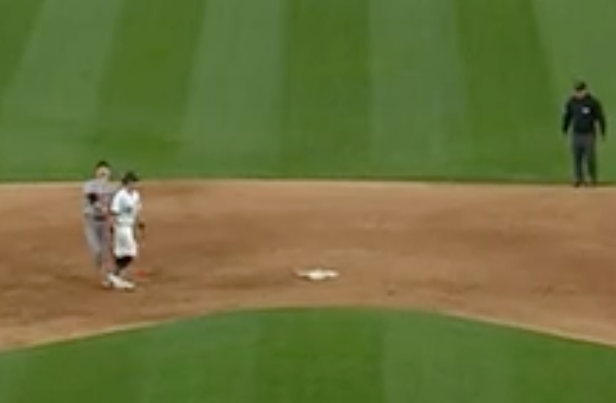Take a moment to watch this video:
If you don’t know the rules of baseball inside and out this play doesn’t make any sense at all. The first clue is when the announcer says “infield fly rule”, which is the canonical “you aren’t a real baseball fan if you don’t understand this rule” rule. The idea is that if there are runners on first and second with fewer than two out and the batter hits a popup, the fielder can force a double play. If the fielder simply drops the ball, they can pick it up and get forceout double play by throwing to third. But if the runner heads to third to avoid that double play, the fielder can catch the ball and throw to second in order to get the second out there. So baseball added the rule that the batter is just out if the umpire thinks the fielder can catch the ball. It’s a simple solution to an unusual edge case.
Obviously the announcers know this rule and helpfully told the audience about it when they noticed the umpire signal an out. But they didn’t notice or think much of something else the umpire saw:

As you can see, the fielder brushed past the runner going back to second base. That’s interference as defined by Rule 6.01(a)(10):
It is interference by a batter or a runner when . . . [the runner] fails to avoid a fielder who is attempting to field a batted ball.
There’s even a comment in the official rules about what happens when there’s interference on an infield fly:
If interference is called during an Infield Fly, the ball remains
alive until it is determined whether the ball is fair or foul. If fair,
both the runner who interfered with the fielder and the batter
are out. If foul, even if caught, the runner is out and the batter
returns to bat.
So there you go: double play. Case closed.
Obvious not or I wouldn’t be writing about it. Fundamentally we know this is the wrong way to end a game. It’s a popup, which the fielder caught. The runner didn’t try to advance, but just wandered back to second. That’s one out, not two. The announcers figured it out pretty quickly, but called it “as strange a finish as you will ever see in a Major League game”.
Nobody, not the announcers, not the runner, not the fielder, not the umpires, thought the ball would be dropped. Yes the runner failed to get out of the way, but there was plenty of time to catch the “mile-high popup”. So unless the runner wrestled the shortstop to the ground or something equally outrageous, he should be forgiven for not getting out of the way of the fielder who was coming up behind him.
If that had happened, there would have been only one out on the play—the infield fly. That would have given the batting team one last out to tie or win the game. If this had happened in the third inning or somesuch, it would have been frustering, but to end the game on a phantom double play defeats the goal of having baseball at all. This sort of ending isn’t satisfying for the fans.
The rules, including the infield fly and interference, exist to keep the game entertaining to fans. We don’t want fielders to game the system so that they can get two outs on a routine popup. We don’t want runners to interfere with the fielders so they can’t make routine outs. Umpires have discretion over the rules they enforce and they should use their judgement to avoid ruining a game that people spent time and money to see.
That can’t always happen, of course. If the game ends on a bases-loaded walk, that’s not very exciting.[1] But that’s on the pitcher,[2] not the umpire. We want to be thrilled or let down by players not the umpires. I want umpires to know the rules, apply them fairly and from time to time stick the rulebook in their pocket to ignore rules that don’t make sense to enforce.